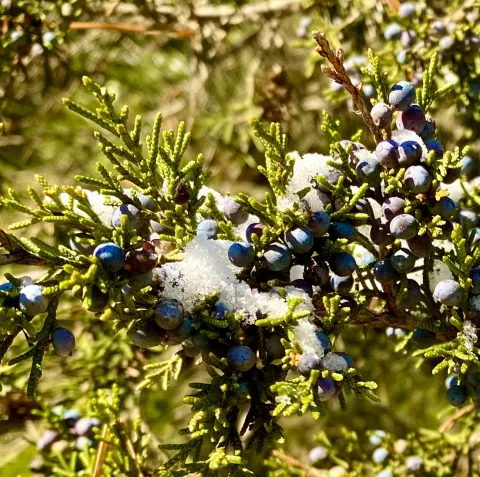Eastern Red Cedar

By: Steve Roark
Volunteer, Cumberland Gap National Historical Park
Eastern Red Cedar (Juniperus virginiana) needs no introduction around here. There's no place you can go without seeing it in some fence row, abandoned field, or empty lot. It can also be found growing on rocky areas where the soil is very thin.
The name "cedar" is misleading, because our red cedar is not a true member of the cedar family like the famous Cedars of Lebanon. Early explorers probably called them cedars because they were evergreen and the wood was red and aromatic. Red Cedar is actually in a family of plants called junipers.
Red Cedar is easy to identify with its broad, cone shaped top, small scale-like needles, and small blue berry-like fruit. The bark is brown and shreddy, and the wood inside has that bright red heartwood and cedar smell.
Early settlers used cedar for many construction projects. Since the heartwood is decay resistant, it was used for fence posts, fence rails, log cabins, roof shingles, furniture, and coffins. The wood split easily and smoothed up nicely. At the turn of the century cedar was in such high demand for pencil manufacturing that large cedars actually became scarce for a time. Today cedar wood is still used for furniture making, especially chests, where clothes are protected from moth damage because of the wood's strong odor. Closets lined with cedar are also popular.
Red cedar is called a "pioneer species", one that rapidly moves into open areas like old fields and takes over for a while. They help improve the soil for other species that will eventually move into the field, such as oak and maple. The reason cedars are so common in fencerows is probably because birds transport them. The Cedar Waxwing, Bluebird, Finch, Grosbeak, and Mockingbird will eat the fleshy berry and excrete the seed out while they rest on barbed wire fences, thus placing cedar seeds where they will not be mowed down or plowed up.
The cedars also provide songbirds with excellent nesting areas, where they can raise their young high up and well hid. In the winter the dense foliage provides cover from wind and snow and is utilized by several wildlife species.
- Log in to post comments